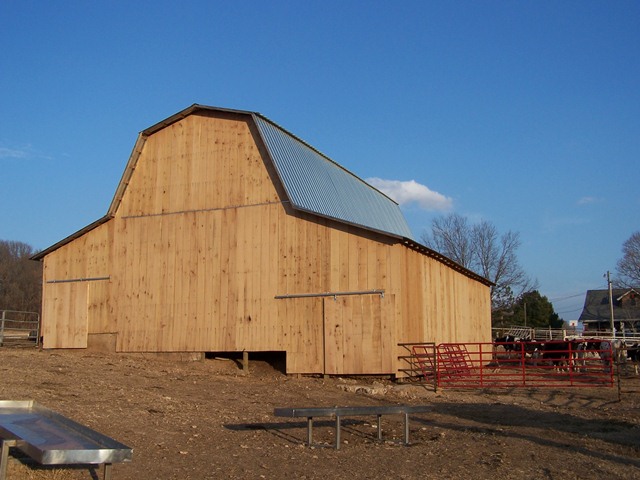Wood Choices for Barn Siding
Other Versions
Spanish
What kind of trees make good board siding for a barn? April 24, 2014
Question (WOODWEB Member) :
I would like to build a small barn and would like to know what wood would be best to use for the siding. I have 4/4 red oak, white oak, hickory, ash, elm and walnut. I also have some cedar but not enough to build with.
Forum Responses
(Sawing and Drying Forum)
From Gene Wengert, forum technical advisor:
I would favor white oak for two reasons. It is naturally decay resistant and it is not often easy to get much money for on the market today. On the other hand, it does cup quite a bit, so you would be satisfied if it were quartersawn or close to quartersawn. It is also heavy and so you will develop a few extra muscles. As you put it up you will likely notice that it looks great and wonder why you are wasting such beauty on a barn.
As siding is more for beauty than function, I would think that you might consider 1/2" pieces rather than full 1". Or you might have the attachment that lets you saw beveled (or tapered) siding, or were you going to use board and batten pattern? Of the other species, elm is probably the one most prone to warp and should be avoided.
From contributor R:
I would go with the red oak and/or white oak as the two main woods. I would also recommend one inch thickness. You expect the barn to be there for a long time and the thicker woods will serve you best.
From Contributor T:
I wouldn't go thicker than 1/2" - and would certainly not use red oak. We have the original long leaf pine siding on a house built around 1850. The siding on the west is paper thin and needs to be replaced but the siding on the north is still quite functional.
From contributor R:
I have a barn that is approximately 80% one inch thickness red oak. It has been there for 30 years. Half inch is too thin and will not stand up near as well as one inch stock.
From Gene Wengert, forum technical advisor:
To contributor R: Can you clarify what you mean by the statement that 1/2" won't stand up as well? Also, do you have B&B or lap siding? What is the width of the pieces? What is the spacing of the vertical framing supports? Do you also have horizontal framing pieces, in addition to siding? Do you have diagonal supports in the corners or sheathing?
From Contributor T:
If exposed to the weather red oak siding would rot away in less than three years in these parts - south central Louisiana.
From contributor R:
Iím located on the TN/KY border and red oak lasts a long time here. Thickness stock is substantially tougher than 1/2 " stock. It will withstand cows running into it, careless use of a tractor (to a certain degree), and the test of time. This is a pretty much moot point as the original poster has 1" thick stock and is probably not going to reduce it to 1/2".
From Contributor Y:
If you have the walnut, and are so inclined, go for it! It is the most stable and durable wood in your list - and a couple hundred years from now when someone reclaims that siding it'll be like hitting a gold mine. Second would be white oak, then red oak. Save the hickory for cabinets, smoking meat, and firewood. It is hard to mill, and not very durable. I favor board and bat siding. Easy to mill, and can go up green, right off the sawmill. Below is a 100 plus year old dairy barn I cut the siding for - all oak.

Click here for higher quality, full size image
"Photo by Dave Boyt"
From contributor B:
As long as your siding is not in contact with the ground, any of those woods should last for a very long time. Around here (Southwestern PA) there are barns with siding of just about every kind of wood you can imagine; red and white oak, yellow poplar, cucumber magnolia, pine, hemlock and the list goes on. These barns are easily 50 plus years old.
From Contributor P:
Use whatever you have and donít be afraid to mix species. White oak is best but Iíve built all my barns and buildings out of all mixed species and 20 years later they are in excellent shape. Use what you like and it also matters how you frame and skirt the building. I would keep the widths as narrow as you can to prevent cup.
